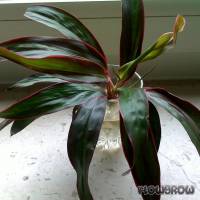



Cordyline fruticosa is one of those ornamental plants regularly sold in the aquarium trade and are quite popular due to their striking colours but die off sooner or later under water and rot away. It is not even a marsh plant but a terrestrial plant that does badly in constantly moist soil.
The palm lily is a palm-like brush when fully grown. It has upright, up to 3 to 4 metres high trunks with a tuft of lanceolate shining leaves on leafstalks on the end. It differs from resembling Dracaena species e.g. as its longitudinal leaf nerves don't run totally parallel with its leaf midrib but branch away from it pinnately (see fig. 3).
C. fruticosa presumably comes originally from South-East Asia and Papua New Guinea and was brought to many Pacific islands like e.g. Hawaii and New Zealand by the early Polynesians. It also occurs spontaneously in eastern Australia and some islands of the Indian Ocean. In the South Sea, this plant is intensively used in many ways, e.g. as food plant; its edible rhizomes are high in starch. Today it is spread in all the world as houseplant and ornamental plant for tropical gardens.
There are many cultivars of this plant differing in colour, pattern, leaf length and width. It is also often sold under the synonym Cordyline terminalis or erroneously as Dracaena species. In the aquatic plant trade, mostly the "Firebrand" cultivar is sold (Dracaena 'Firebrand').
Cordyline fruticosa can be kept as houseplant or terrarium plant, however, it has relatively high demands. A light place, but not in full sun, room temperature (not under 13 °C), high air humidity and constantly moist but not waterlogged potting soil are recommended. Propagation is best done by 7 to 12 cm long cuttings of the stems that are laid into a sandy substrate that is constantly kept warm. The plant will sprout new shoots from lateral buds, which can be separated from the stem piece and planted into pots as soon as they have developed 4 to 6 leaves.
<a href="https://www.flowgrow.de/db/aquaticplants/cordyline-fruticosa-c-terminalis" target="_blank"><img alt="Cordyline fruticosa" title="Cordyline fruticosa" src="https://www.flowgrow.de/db/widget/aquaticplants/cordyline-fruticosa-c-terminalis" /></a>
[url=https://www.flowgrow.de/db/aquaticplants/cordyline-fruticosa-c-terminalis][img]https://www.flowgrow.de/db/widget/aquaticplants/cordyline-fruticosa-c-terminalis[/img][/url]
[widget=aquaticplants/cordyline-fruticosa-c-terminalis]Cordyline fruticosa[/widget]